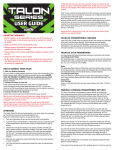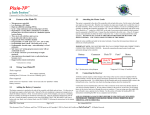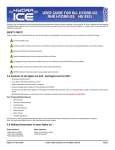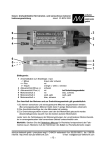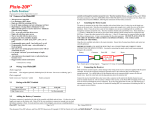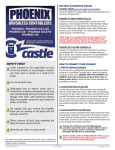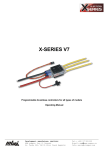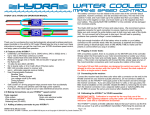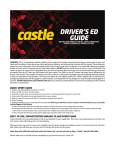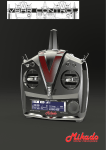Download SKRHQL[078™
Transcript
Warning! High power motor systems can be very dangerous! High currents can heat wires and batteries, causing fires and burning skin. Follow the wiring directions carefully! Model aircraft equipped with high power motors can kill. Always fly at a sanctioned field. Never fly over or near spectators. Even though this controller is equipped with a safety arming program, you should still use caution when connecting the main battery. PHOENIX PHOENIXENIX-45™ By Castle Creations 45 amp Brushless Sensorless Speed Control 1.0 • • • • • • • • • • • • • • Features of the Phoenix-45™: IMPORTANT NOTE: YOU MUST BE SURE THAT THE POLARITY IS CORRECT WHEN CONNECTING THE SPEED CONTROLLER. Incorrect polarity could permanently damage the controller. Extremely Low Resistance (.0026 ohms) High rate adjustable switching (PWM) Up to 45 amps continuous current with proper air flow, 60 amps surge Five to ten cells with four micro servos Up to twelve cells with three micro servos Sixteen cells MAX (with BEC disabled) Dynamic braking ensures folding props fold promptly BEC (3A) provides power to receiver and servos eliminates separate receiver battery User Programmable Features: • Low-voltage cutoff including Auto-Lipo as default • Over-current Protection • Brake Type • Throttle Range – fixed/self-adjusting/governor • Timing Advance • Cutoff Type • Soft Start ramp up • Switching Frequency Runs motor in forward OR reverse Auto Motor Cutoff with Reset Safe “power on” arming program ensures motor will not accidentally turn on Low torque “soft start” prevents damage to fragile gearboxes Auto shut down when signal is lost or radio interference becomes severe 2.3 2.4 Wire strippers (optional) Battery 2.1 2.2 5-6 cells 5 4 2.5 Connecting the Receiver Older AirTronics systems require a minor change to the wiring in the receiver connector supplied with the speed controller. Reverse the red (power) and brown (ground) wires in the connector plug so that the plug is orange/brown/red. Use a knife blade to lift the retention tabs on the connector plug to remove the red and brown wires. Insert the wires back into the plug and press down the retention tab. 3.0 Battery connector 9-10 cells 4 3 Motor Connect the receiver lead (the three color twisted wires with a connector on the end) to the throttle channel on your receiver (usually channel 3). Do not connect a battery to the receiver, as the Phoenix-45™ will supply power to the receiver and servos through the receiver connector. If you are using more than 12 cells, you must use a separate receiver battery. See the section 4.0 (under the heading BEC) for instructions on disabling the BEC to use a separate receiver battery. Soldering Iron (25-40) 7-8 cells 5 4 Phoenix-45™ Fig 1: Motor wiring diagram Servo Ratings with BEC Enabled Servo Type Standard (micro) servos High Torque servos Connector Phoenix-45™ Parts required: Solder (rosin core “electronic” solder) Reversing Rotation Bench test the motor connections noting the rotation of the motor. To change the rotation of the motor, swap ANY two motor wire connections. 2.0 Wiring Your Phoenix-45™: Tools required: Wire cutters Connecting the Motor The motor is connected to the side of the controller that has THREE power wires. Cut the wires to the length you require on the motor side. DO NOT CUT the wires leading from the motor. Strip the wire insulation to expose just enough wire to solder the wires to the motor terminals. There should be three wires extending from the motor. Connect the three speed control wires to the three motor wires. Align the wires carefully and solder to the motor wires. Ensure that all connections (battery and motor) are correctly polarized. 11-12 cells 3 2 Adding the Battery Connector The battery connector is attached to the side of the controller that has only two power wires, and also has the radio connector. Cut the wires to the length you require on the battery side. Strip off of the wire insulation to expose just enough wire to attach the battery connector. (Note: if you do not have a pair of wire strippers, you can use a modeling knife to carefully cut through the insulation around the wire. Then the insulation should easily pull off the wire.) Attach the battery connector to the wires ENSURING THAT THE POLARITY (red wire to battery red wire, black wire to battery black wire) IS CORRECT, following the instructions for the battery connector. PHOENIX-45™ User Guide Page 1 of 6 Flying with Your Phoenix-45™: ALWAYS PERFORM A RANGE CHECK BEFORE FLYING WITH ANY NEW SPEED CONTROLLER! PERFORM YOUR RANGE CHECK AT FULL THROTTLE, HALF THROTTLE AND NO THROTTLE. Initialization sequence: 1. Connect the speed controller receiver connector to the proper channel on your receiver (usually channel 3) 2. Turn on your transmitter. 3. Connect the main power battery to the speed controller. 4. The speed controller will remain disarmed (will not operate) until it sees more than four seconds of “brake” throttle. Move the throttle arm to the lowest position on your transmitter, wait at least four seconds, and then test the controller to make sure that the throttle operates. 5. Go fly! 6. If the ESC cutoff occurs before you land, you may restart the motor and use low throttle if necessary by moving the throttle stick all the way down (to the brake position) and then throttling back up. ESC cutoff will occur again if the voltage drops too low. Rev 5-date 09/01/04 This document, Phoenix-45™ software, and Phoenix-45™ PCB layout are all Copyright 2002-2003 by Patrick del Castillo and Castle Creations Warning! High power motor systems can be very dangerous! High currents can heat wires and batteries, causing fires and burning skin. Follow the wiring directions carefully! Model aircraft equipped with high power motors can kill. Always fly at a sanctioned field. Never fly over or near spectators. Even though this controller is equipped with a safety arming program, you should still use caution when connecting the main battery. PHOENIX PHOENIXENIX-45™ By Castle Creations 45 amp Brushless Sensorless Speed Control 4.0 Using the Features of Your Phoenix-45™ BEC - The BEC power is supplied to the receiver and servos through the receiver connector wires. If you wish to disable the BEC and use a separate receiver battery (required for the use of more than twelve cells), you must first cut the red wire in the trio of receiver wires. Simply use a pair of wire cutters to remove a short section of the red wire near the receiver connector, and be sure to insulate the cut wire with a bit of electrical tape. Then you may safely use a battery with your receiver. Brake - moving the transmitter throttle stick to the bottom position enables the prop brake. Cutoff - The motor cutoff will occur when the input battery voltage drops below the programmed cutoff voltage for more than one half second. Once motor cutoff has occurred, moving the throttle to the braking position (full off) can re-arm the controller. This will allow restart of the motor at low throttle after cutoff has occurred. WARNING: Repeated restarting of the motor may drain the battery to a point where the radio receiver will stop operating, resulting in a loss of control of the model. Loss of Transmitter Signal, or excessive radio noise cutoff - Motor cutoff will also occur if the signal from the transmitter is lost, or if the radio noise becomes excessive. After radio connection has been reestablished, moving the throttle to the braking position (full off) for one second can restart the motor. Safe Power Up - The Safe Power up feature is a “finger saver”, designed to prevent the motor from starting accidentally on power up. To arm the controller, the transmitter stick must be held in the “Brake” position (all the way down) for at least four seconds. Until the controller is armed, it will not provide any power to the motor, regardless of where the throttle stick on your transmitter is positioned. Before flying your model, be sure to “blip” the throttle to ensure that the controller is armed. LED – The LED is used for programming the features on the Phoenix-45™. Once armed, the LED also provides an indication that the controller has reached full throttle by lighting solid when full throttle is reached. If the unit is in Auto-Calibrating Throttle mode (program setting 4-1) then you may see full throttle LED indication before the stick is in the full up position. Simply continue moving the stick to full up. The controller will detect the high stick travel and adjust full throttle accordingly. 5.0 Troubleshooting The LED comes on when I throttle up. This is normal. The LED comes on when full throttle has been reached. If the unit is in Auto-Calibrating Throttle mode (program setting 4-1) then you may see full throttle LED indication before the stick is in the full up position. Simply continue moving the stick to full up. The controller will detect the high stick travel and adjust full throttle accordingly. Nothing seems to work, receiver and servos are dead, and the throttle is dead. Check all connections to ensure that they are correct, and that the polarity (+/-) connections are correct. If everything is correctly connected, and the receiver and servos still do not work, contact the dealer where you purchased your Phoenix-45™ or Contact Castle Creations directly. (See info below) 6.0 Contact / Warranty Information Your Phoenix-45™ is warranted for one(1) year from date of purchase to be free from manufacturing and component defects. This warranty does not cover abuse, neglect, or damage due to incorrect wiring, over voltage, or overloading. If you have any questions, comments, or wish to return your Phoenix-45™ for warranty or non-warranty repair/replacement contact Castle Creations at: Castle Creations 402 E. Pendleton Ave. Wellsville, KS 66092 Tel: (785) 883-4519 7.0 Email: [email protected] Fax: (785) 883-4571 Website: http://www.castlecreations.com Phoenix-45™ Programming Features Programming the Phoenix-45™ Programming the Phoenix-45™ is as simple as answering a few questions. The Phoenix-45™ asks questions by flashing a setting number, followed by the possible setting values. There are eight settings that can be programmed in the Phoenix-45™: 1) Cutoff voltage, 2) Current Limiting, 3) Brake Type, 4) Throttle Type, 5) Timing Advance, 6) Cutoff Type, 7) Soft Start, and 8) PWM Switching Frequency. Everything is hooked up correctly, the BEC (receiver and servos) works, but the throttle does not work. The controller is not seeing the four seconds of “dead space” (low throttle) and is not arming. Try moving your throttle stick all the way down, and moving the trim all the way down. Wait for four seconds and try the throttle again. If it still does not arm, you may need to reverse the throttle control on your transmitter (see your radio documentation). You may also check to make sure that your endpoint adjustments on your radio (if it has them) are set all the way open. As the programmer, you must answer “yes” or “no” to the setting values as they are presented by the Phoenix-45™. The setting values are “flashed” out by the LED. Answering “no” to a setting value will cause the Phoenix-45™ to ask for the next value. Answering “yes” to a setting value will store that setting in the Phoenix-45™s permanent memory. After a setting is stored, the Phoenix-45™ will continue to ask about other settings until all settings have been stored. NOTE: If you answer “no” to all values for a particular setting, the Phoenix-45™ will keep whatever value had been previously programmed. Only by answering “yes” to a value will the Phoenix-45™ store/change that value. Every time I throttle all the way up, the controller “cuts off” after a few seconds, even with fresh charged batteries. The controller will automatically shut down the motor if the battery voltage falls below the programmed voltage cutoff (factory preset at 5.0V) for more than half a second. This is to protect your airplane from a loss of control caused by too low a voltage at the receiver. If the cutoff is kicking in with fresh charged batteries, it means that the voltage is dropping very quickly. This is usually an indication of a motor that is drawing too much current for the batteries to handle. Try using a smaller prop on the motor, or using batteries with a higher rating (for example, if you are using 800AR cells, you might try going to 1000SCR cells.) When answering a question, you will need to move the transmitter stick to the yes (full on throttle) position or the no (full off throttle) position and keep it there for about 5 seconds. When the Phoenix-45™ has accepted your answer, it will flash the LED rapidly. After the LED starts it’s rapid flashing, move the throttle stick to the middle position to confirm that you are ready for the Phoenix-45™ to ask the next question. PHOENIX-45™ User Guide Page 2 of 6 You are not required to continue through all eight programming options. For example, if you wish only to change the Cutoff Voltage (option 1) then after programming that setting you can disconnect power from the Phoenix-45™ and proceed to the arming sequence (see Section 3.0). Disconnecting the controller in the middle of programming simply retains the values for the remaining programming options that were previously set up. Rev 5-date 09/01/04 This document, Phoenix-45™ software, and Phoenix-45™ PCB layout are all Copyright 2002-2003 by Patrick del Castillo and Castle Creations Warning! High power motor systems can be very dangerous! High currents can heat wires and batteries, causing fires and burning skin. Follow the wiring directions carefully! Model aircraft equipped with high power motors can kill. Always fly at a sanctioned field. Never fly over or near spectators. Even though this controller is equipped with a safety arming program, you should still use caution when connecting the main battery. PHOENIX PHOENIXENIX-45™ By Castle Creations 45 amp Brushless Sensorless Speed Control 8.0 8.2.7 8.2.8 Entering Programming Mode The Phoenix-45™ software is designed to make it difficult to accidentally enter programming mode, therefore it may seem like a long process to enter programming mode. This is to prevent entering programming mode while preparing to fly or while in flight. To enter programming mode, follow the steps below: 8.1 Verify Normal Operation If this is the first time the Phoenix-45™ has been used, it is important to verify that the Phoenix-45™ operates normally with your transmitter otherwise programming may not function properly. Follow the instructions in section 3.0 Initialization Sequence (steps 1-4). Once you have verified that the Phoenix-45™ operates normally, proceed to 8.2 below. If the Phoenix-45™ does not operate properly, see section 5.0, Troubleshooting. 8.2 Enter Programming Mode 8.2.1 8.2.2 8.2.3 8.2.4 Remove battery power from the Phoenix-45™. Move the transmitter stick to the top position (normally full “On”). Reconnect battery power to the Phoenix-45™. After approximately 2 seconds, the Phoenix-45™ will emit a short tone, and the LED on the Phoenix-45™ should flash a short, single flash followed by a pause. Phoenix-45™ responds: flash – pause 8.2.5 8.2.6 Move your transmitter stick to the middle position. After approximately 2 seconds, the Phoenix-45™ will emit a short tone, and the LED on the Phoenix-45™ should flash a short, double flash followed by a pause. Phoenix-45™ responds: flash – flash – pause Phoenix-45™ responds: flash – flash – flash – pause 8.2.9 8.2.10 Move your transmitter stick back to the middle position again. After approximately 2 seconds, the Phoenix-45™ will emit four short tones, and the LED on the Phoenix-45™ will start a flash sequence of a single flash followed by another single flash, followed by a long pause. Phoenix-45™ responds: flash – flash – pause 8.2.11 8.2.12 The Phoenix-45™ is now in programming mode, and asking you the first question in section 9.1 Proceed to Section 9.0 – Programming the Phoenix-45™ 9.0 Programming the Phoenix-45™ Important Note: When answering a question, you will need to move the transmitter stick to the yes (full “On” throttle) position or the no (full “Off” throttle) position and keep it there for about 2 seconds. When the Phoenix-45™ has accepted your answer, it will flash the LED rapidly. After the LED starts it’s rapid flashing, move the throttle stick to the middle position to confirm that you are ready for the Phoenix-45™ to ask the next question. If you wish to re-program only some of the features you do not need to continue through the programming steps for the remaining settings. Once you have programmed each of the features you wish to change and the Phoenix-45™ has confirmed the selection, instead of returning to mid-throttle for the next question, disconnect battery power, re-connect power, and arm the speed control as normal (see Section 3.0). NOTE: When setting Lipo cut off voltage follow your battery manufactures recommendations. *Factory default settings are indicated by an asterisk in the option listings below. 9.1 Move your transmitter stick to the top position again. After approximately 2 seconds, the Phoenix-45™ will emit a short tone, and the LED on the Phoenix-45™ should flash a short, triple flash followed by a pause. Programming Setting 1 –Cutoff Voltage Setting Option 1: Auto-Lipo * Option 2: 4.0V cutoff voltage Option 3: 5.0V cutoff voltage Recommended for use with: Auto-detects Lipo cell count, and sets 3v/cell cutoff 5 cell NiCad or NiMH packs 6-8 cell NiCad or NiMH packs, Setting Option 4: 6.0V cutoff voltage Option 5: 9.0V cutoff voltage Option 6: 12.0V cutoff voltage Phoenix-45™ Displays: 1 flash – short pause – 1 flash – long pause Programming Question Asked: Setting 1 (cutoff voltage), Option 1 (Auto-Lipo)? Yes – Throttle stick in up position Your Response: 1 flash – short pause – 2 flashes – long pause Setting 1 (cutoff voltage), Option 2 (4.0V)? Yes – Throttle stick in up position 1 flash – short pause – 3 flashes – long pause Setting 1 (cutoff voltage), Option 3 (5.0V)? No – Throttle stick in off position No – Throttle stick in off position Yes – Throttle stick in up position No – Throttle stick in off position PHOENIX-45™ User Guide Page 3 of 6 Recommended for use with: _________________ 7-10 cell NiCad or NiMH packs, or 2 cell Lithium packs 12-14 cell NiCad, 12-16 cell NiMH, or 3 cell Lithium packs 16 cell Nicad packs, or 4 cell Lithium packs Phoenix-45™ Action: Stores selection. Flashes rapidly to confirm receipt of your response. Flashes rapidly to confirm receipt of your response. Your Action: Return Tx stick to center and proceed to next setting–Current Limiting (9.2 below) Return Tx stick to center and proceed to next option for this setting Stores selection. Flashes rapidly to confirm receipt of your response. Flashes rapidly to confirm receipt of your response. Return Tx stick to center and proceed to next setting–Current Limiting (9.2 below) Return Tx stick to center and proceed to next option for this setting Stores selection. Flashes rapidly to confirm receipt of your response. Flashes rapidly to confirm receipt of your response. Return Tx stick to center and proceed to next setting–Current Limiting (9.2 below) Return Tx stick to center and proceed to next option for this setting Rev 5-date 09/01/04 This document, Phoenix-45™ software, and Phoenix-45™ PCB layout are all Copyright 2002-2003 by Patrick del Castillo and Castle Creations PHOENIXPHOENIX-45™ By Warning! High power motor systems can be very dangerous! High currents can heat wires and batteries, causing fires and burning skin. Follow the wiring directions carefully! Model aircraft equipped with high power motors can kill. Always fly at a sanctioned field. Never fly over or near spectators. Even though this controller is equipped with a safety arming program, you should still use caution when connecting the main battery. Castle Creations 45 amp Brushless Sensorless Speed Control Phoenix-45™ Displays: 1 flash – short pause – 4 flashes – long pause Programming Question Asked: Setting 1 (cutoff voltage), Option 4 (6.0V)? 1 flash – short pause – 5 flashes – long pause Setting 1 (cutoff voltage), Option 5 (9.0V)? 1 flash – short pause – 6 flashes – long pause Setting 1 (cutoff voltage), Option 6 (12.0V)? Your Response: Yes – Throttle stick in up position No – Throttle stick in off position Yes – Throttle stick in up position No – Throttle stick in off position Yes – Throttle stick in up position No – Throttle stick in off position 9.2 Phoenix-45™ Action: Stores selection. Flashes rapidly to confirm receipt of your response. Flashes rapidly to confirm receipt of your response. Your Action: Return Tx stick to center and proceed to next setting–Current Limiting (9.2 below) Return Tx stick to center and proceed to next option for this setting Stores selection. Flashes rapidly to confirm receipt of your response. Flashes rapidly to confirm receipt of your response. Return Tx stick to center and proceed to next setting–Current Limiting (9.2 below) Return Tx stick to center and proceed to next option for this setting Stores selection. Flashes rapidly to confirm receipt of your response. Flashes rapidly to confirm receipt of your response. Maintains previous setting for cutoff voltage (no change) Return Tx stick to center and proceed to next setting–Current Limiting (9.2 below) Return Tx stick to center and proceed to next setting-Current Limiting (9.2 below) Programming Setting 2 –Current Limiting NOTE: Change this setting at your own risk! Damage to the controller as a result of over current is NOT covered by the manufacturer’s warranty. Only experienced modelers should use this programming feature. Current limiting describes the reaction of the Phoenix-45™ when an over-current condition is detected. There are five options: Option 1: Very sensitive (Very low over-current threshold, will rapidly shut-down) Option 4: Insensitive (High over-current threshold, will shut down after a slight delay) Option 2: Sensitive (Low over-current threshold, will rapidly shut-down) Option 5: Over current disabled (Over current detection disabled) Option 3: Standard * (Moderate over-current threshold, will shut down after a slight delay) Phoenix-45™ Displays: 2 flashes - short pause –1 flash – long pause Programming Question Asked: Setting 2 (current limiting), Option 1 (Very sensitive)? Your Response: 2 flashes - short pause – 2 flashes – long pause Setting 2 (current limiting), Option 2 (Sensitive)? 2 flashes - short pause – 3 flashes – long pause Setting 2 (current limiting), Option 3 (Standard)? Yes – Throttle stick in up position 2 flashes - short pause – 4 flashes – long pause Setting 2 (current limiting), Option 4 (Insensitive)? Yes – Throttle stick in up position 2 flashes - short pause – 5 flashes – long pause Setting 2 (current limiting), Option 5 (Disabled)? Yes – Throttle stick in up position No – Throttle stick in off position Yes – Throttle stick in up position No – Throttle stick in off position No – Throttle stick in off position No – Throttle stick in off position Yes – Throttle stick in up position No – Throttle stick in off position 9.3 Phoenix-45™ Action: Stores selection. Flashes rapidly to confirm receipt of your response. Flashes rapidly to confirm receipt of your response. Your Action: Return Tx stick to center and proceed to next setting–Brake Type (9.3 below) Return Tx stick to center and proceed to next option for this setting Stores selection. Flashes rapidly to confirm receipt of your response. Flashes rapidly to confirm receipt of your response. Return Tx stick to center and proceed to next setting–Brake Type (9.3 below) Return Tx stick to center and proceed to next option for this setting Stores selection. Flashes rapidly to confirm receipt of your response. Flashes rapidly to confirm receipt of your response. Return Tx stick to center and proceed to next setting–Brake Type (9.3 below) Return Tx stick to center and proceed to next option for this setting Stores selection. Flashes rapidly to confirm receipt of your response. Flashes rapidly to confirm receipt of your response. Return Tx stick to center and proceed to next setting–Brake Type (9.3 below) Return Tx stick to center and proceed to next option for this setting Stores selection. Flashes rapidly to confirm receipt of your response. Flashes rapidly to confirm receipt of your response. Maintains previous setting for Current Limiting (no change). Return Tx stick to center and proceed to next setting–Brake Type (9.3 below) Return Tx stick to center and proceed to next setting – Brake Type (9.3 below). Programming Setting 3 – Brake Type Delayed brake provides a 4-second delay before braking occurs. Soft brake provides 50% of full braking power; hard brake is 100% braking power. Hard brake should only be used on 10 cells or less. Option 1: Soft delayed brake * General aircraft use, with fixed or folding prop Option 2: Hard delayed brake Direct drive applications where more braking power is required Option 3: Soft brake, no delay Competition use where a very short brake delay is required Phoenix-45™ Displays: 3 flashes - short pause – 1 flash – long pause Programming Question Asked: Setting 3 (brake type), Option 1 (soft, delayed 4-seconds)? Your Response: Yes – Throttle stick in up position No – Throttle stick in off position Option 4: Hard brake, no delay Competition use where a very short brake delay is required Option 5: Brake Disabled Helicopters Phoenix-45™ Action: Stores selection. Flashes rapidly to confirm receipt of your response. Flashes rapidly to confirm receipt of your response. PHOENIX-45™ User Guide Page 4 of 6 Rev 5-date 09/01/04 This document, Phoenix-45™ software, and Phoenix-45™ PCB layout are all Copyright 2002-2003 by Patrick del Castillo and Castle Creations Your Action: Return Tx stick to center and proceed to next setting–Throttle Type (9.4 below) Return Tx stick to center and proceed to next option for this setting PHOENIXPHOENIX-45™ By Warning! High power motor systems can be very dangerous! High currents can heat wires and batteries, causing fires and burning skin. Follow the wiring directions carefully! Model aircraft equipped with high power motors can kill. Always fly at a sanctioned field. Never fly over or near spectators. Even though this controller is equipped with a safety arming program, you should still use caution when connecting the main battery. Castle Creations 45 amp Brushless Sensorless Speed Control Phoenix-45™ Displays: 3 flashes - short pause – 2 flashes – long pause Programming Question Asked: Setting 3 (brake type), Option 2 (hard, delayed 4-seconds)? Your Response: 3 flashes - short pause – 3 flashes – long pause Setting 3 (brake type), Option 3 (soft, no delay)? Yes – Throttle stick in up position 3 flashes - short pause – 4 flashes – long pause Setting 3 (brake type), Option 4 (hard, no delay)? Yes – Throttle stick in up position 3 flashes - short pause – 5 flashes – long pause Setting 3 (brake type), Option 5 (brake disabled)? Yes – Throttle stick in up position No – Throttle stick in off position No – Throttle stick in off position No – Throttle stick in off position Yes – Throttle stick in up position No – Throttle stick in off position 9.4 Phoenix-45™ Action: Stores selection. Flashes rapidly to confirm receipt of your response. Flashes rapidly to confirm receipt of your response. Your Action: Return Tx stick to center and proceed to next setting–Throttle Type (9.4 below) Return Tx stick to center and proceed to next option for this setting Stores selection. Flashes rapidly to confirm receipt of your response. Flashes rapidly to confirm receipt of your response. Return Tx stick to center and proceed to next setting–Throttle Type (9.4 below) Return Tx stick to center and proceed to next option for this setting Stores selection. Flashes rapidly to confirm receipt of your response. Flashes rapidly to confirm receipt of your response. Return Tx stick to center and proceed to next setting–Throttle Type (9.4 below) Return Tx stick to center and proceed to next option for this setting Stores selection. Flashes rapidly to confirm receipt of your response. Flashes rapidly to confirm receipt of your response. Maintains previous setting for Brake Type (no change). Return Tx stick to center and proceed to next setting–Throttle Type (9.4 below) Return Tx stick to center and proceed to next setting–Throttle Type (9.4 below) Programming Setting 4 – Throttle Type Option 1: Auto Calibrating throttle* Option 2: Fixed throttle Recommended for general aircraft Fixed pitch helicopters Phoenix-45™ Displays: 4 flashes - short pause – 1 flash – long pause Programming Question Asked: Setting 4 (throttle type), Option 1 (auto calibrating)? 4 flashes - short pause – 2 flashes – long pause Setting 4 (throttle type), Option 2 (fixed)? 4 flashes - short pause – 3 flashes – long pause Setting 4 (throttle type), Option 3 (Governor mode Low RPM range)? 4 flashes - short pause – 4 flashes – long pause Setting 4 (throttle type), Option 4 (Governor mode High RPM range)? Option 3: Governor Mode – Low RPM Range (see Note below) Option 4: Governor Mode – High RPM Range (see Note below) Your Response: Yes – Throttle stick in up position No – Throttle stick in off position Yes – Throttle stick in up position No – Throttle stick in off position Yes – Throttle stick in up position No – Throttle stick in off position Yes – Throttle stick in up position No – Throttle stick in off position Recommended for collective pitch helicopters Recommended for collective pitch helicopters Phoenix-45™ Action: Stores selection. Flashes rapidly to confirm receipt of your response. Flashes rapidly to confirm receipt of your response. Your Action: Return Tx stick to center and proceed to next setting–Timing Advance (9.5 below) Return Tx stick to center and proceed to next option for this setting Stores selection. Flashes rapidly to confirm receipt of your response. Flashes rapidly to confirm receipt of your response. Return Tx stick to center and proceed to next setting–Timing Advance (9.5 below) Return Tx stick to center and proceed to next option for this setting Stores selection. Flashes rapidly to confirm receipt of your response. Flashes rapidly to confirm receipt of your response. Return Tx stick to center and proceed to next setting–Timing Advance (9.5 below) Return Tx stick to center and proceed to next option for this setting Stores selection. Flashes rapidly to confirm receipt of your response. Flashes rapidly to confirm receipt of your response. Maintains previous setting for throttle (no change). Return Tx stick to center and proceed to next setting–Timing Advance (9.5 below) Return Tx stick to center and proceed to next setting–Timing Advance (9.5 below) NOTE: Governor mode acts as an RPM control, rather than a throttle control. Throttle stick position determines the RPM that the motor runs and the controller will attempt to hold that RPM regardless of load changes. This is useful in a collective pitch helicopter where a constant head speed is desirable. The low RPM range has finer RPM control at lower RPMs, and the high RPM range has finer RPM control at higher RPMS. The low RPM range is useful for low pole count motors (Hacker, etc.) and low RPMs on higher pole count motors. The high RPM range is useful for higher pole count motors and higher RPMs. Brake is ALWAYS disabled in Governor Mode. 9.5 Programming Setting 5 – Electronic timing advance Option 1: High advance timing (12°-35°) Option 2: Standard advance timing (5°-20°) * Option 3: Low advance timing (0°-15°) Recommended for higher pole count motors (eg. Jeti or large Mega motors) Gives more power at the expense of efficiency Recommended for most motors (Aveox, Hacker, Astro, smaller Mega, Kontronik) Gives a good balance of power and efficiency Recommended for use when efficiency or run-time is primary concern – Gives a slight loss of power with a slight increase in efficiency. NOTE: The controller senses the motor type by its inductance, and automatically sets the maximum advance according to motor type (eg: outrunner motors will automatically be run at a higher advance setting) Phoenix-45™ Displays: 5 flashes - short pause – 1 flash – long pause Programming Question Asked: Setting 5 (timing advance), Option 1 (high advance)? Your Response: Yes – Throttle stick in up position No – Throttle stick in off position Phoenix-45™ Action: Stores selection. Flashes rapidly to confirm receipt of your response. Flashes rapidly to confirm receipt of your response. PHOENIX-45™ User Guide Page 5 of 6 Rev 5-date 09/01/04 This document, Phoenix-45™ software, and Phoenix-45™ PCB layout are all Copyright 2002-2003 by Patrick del Castillo and Castle Creations Your Action: Return Tx stick to center and proceed to next setting–Cutoff Type (9.6 below) Return Tx stick to center and proceed to next option for this setting PHOENIXPHOENIX-45™ By Castle Creations 45 amp Brushless Sensorless Speed Control Phoenix-45™ Displays: Programming Question Asked: 5 flashes - short pause – 2 flashes – long pause Setting 5 (timing advance), Option 2 (standard)? 5 flashes - short pause – 3 flashes – long pause Setting 5 (timing advance), Option 3 (low)? Warning! High power motor systems can be very dangerous! High currents can heat wires and batteries, causing fires and burning skin. Follow the wiring directions carefully! Model aircraft equipped with high power motors can kill. Always fly at a sanctioned field. Never fly over or near spectators. Even though this controller is equipped with a safety arming program, you should still use caution when connecting the main battery. Your Response: Yes – Throttle stick in up position No – Throttle stick in off position Yes – Throttle stick in up position No – Throttle stick in off position 9.6 Phoenix-45™ Displays: Programming Question Asked: 6 flashes - short pause – 1 flash – long pause Setting 6 (cutoff type), Option 1 (hard cutoff)? 6 flashes - short pause – 2 flashes – long pause Setting 6 (cutoff type), Option 2 (soft cutoff)? Stores selection. Flashes rapidly to confirm receipt of your response. Flashes rapidly to confirm receipt of your response. Maintains previous setting for timing advance(no change). Return Tx stick to center and proceed to next option for this setting Return Tx stick to center and proceed to next setting–Cutoff Type (9.6 below) Return Tx stick to center and proceed to next setting–Cutoff Type (9.6 below) Option 2: Soft Cutoff (Throttle down at low voltage or over-current) Your Response: Yes – Throttle stick in up position No – Throttle stick in off position Yes – Throttle stick in up position No – Throttle stick in off position Phoenix-45™ Action: Your Action: Stores selection. Flashes rapidly to confirm receipt of your response. Flashes rapidly to confirm receipt of your response. Stores selection. Flashes rapidly to confirm receipt of your response. Flashes rapidly to confirm receipt of your response. Maintains previous setting for Cutoff Type (no change).. Return Tx stick to center and proceed to next setting–Soft Start (9.7 below). Return Tx stick to center and proceed to next option for this setting Return Tx stick to center and proceed to next setting–Soft Start (9.7 below). Return Tx stick to center and proceed to next setting–Soft Start (9.7 below). Programming Setting 7 – Soft Start Option 1: Very soft start Option 2: Soft Start* Recommended for use with fragile gearboxes; governor mode slowest spool up softest start Recommended for most setups; governor mode soft start, slow spool up Phoenix-45™ Displays: Programming Question Asked: Your Response: 7 flashes - short pause – 1 flash – long pause Setting 7 (soft start), Option 1 (very soft start)? 7 flashes - short pause – 2 flashes – long pause Setting 7 (soft start), Option 2 (soft start)? No – Throttle stick in off position Yes – Throttle stick in up position 7 flashes - short pause – 3 flashes – long pause Setting 7 (soft start), Option 3 (fast start)? No – Throttle stick in off position Yes – Throttle stick in up position Yes – Throttle stick in up position No – Throttle stick in off position 9.8 Your Action: Return Tx stick to center and proceed to next setting–Cutoff Type (9.6 below) Programming Setting 6 – Cutoff Type Option 1: Hard Cutoff * (Immediate motor shutdown) 9.7 Phoenix-45™ Action: Stores selection. Flashes rapidly to confirm receipt of your response. Flashes rapidly to confirm receipt of your response. Option 3: Fast start Recommended for fastest startup; governor mode faster start, fast spool up Phoenix-45™ Action: Stores selection. Flashes rapidly to confirm receipt of your response. LED remains on to confirm it is ready to be armed. Flashes rapidly to confirm receipt of your response. Stores selection. Flashes rapidly to confirm receipt of your response. LED remains on to confirm it is ready to be armed. Flashes rapidly to confirm receipt of your response. Stores selection. Flashes rapidly to confirm receipt of your response. LED remains on to confirm it is ready to be armed. Flashes rapidly to confirm receipt of your response. Maintains previous setting for throttle type (no change). Your Action: Return Tx stick to center and proceed to next setting–PWM Rate (9.8 below). Return Tx stick to center and proceed to next option for this setting Return Tx stick to center and proceed to next setting–PWM Rate (9.8 below). Return Tx stick to center and proceed to next option for this setting Return Tx stick to center and proceed to next setting–PWM Rate (9.8 below). Return Tx stick to center and proceed to next setting–PWM Rate (9.8 below). Programming Setting 8 – PWM Switching Rate Option 1: 11 KHz * Recommended for most brushless motors Phoenix-45™ Displays: 8 flashes - short pause – 1 flash – long pause Programming Question Asked: Setting 7 (switching rate), Option 1 (11 KHz)? Option 2: 22 KHz Recommended for low inductance motors Your Response: Yes – Throttle stick in up position No – Throttle stick in off position 8 flashes - short pause – 2 flashes – long pause Setting 7 (timing advance), Option 2 (22KHz)? Yes – Throttle stick in up position No – Throttle stick in off position 8 flashes - short pause – 3 flashes – long pause Setting 7 (timing advance), Option 3 (41KHz)? Yes – Throttle stick in up position No – Throttle stick in off position Option 3: 41 KHz Recommended for very low inductance motors Phoenix-45™ Action: Stores selection. Flashes rapidly to confirm receipt of your response. LED remains on to confirm it is ready to be armed. Flashes rapidly to confirm receipt of your response. Your Action: Programming complete. Proceed to arming section of this User’s Guide (section 3) to arm the unit for flight. Return Tx stick to center and proceed to next option for this setting Stores selection. Flashes rapidly to confirm receipt of your response. LED remains on to confirm it is ready to be armed. Flashes rapidly to confirm receipt of your response. Programming complete. Proceed to arming section of this User’s Guide (section 3) to arm the unit for flight. Return Tx stick to center and proceed to next option for this setting Stores selection. Flashes rapidly to confirm receipt of your response. LED remains on to confirm it is ready to be armed. Flashes rapidly to confirm receipt of your response. Maintains previous setting for throttle type (no change). Programming complete. Proceed to arming section of this User’s Guide (section 3) to arm the unit for flight. Programming complete. Proceed to arming section of this User’s Guide (section 3) to arm the unit for flight. PHOENIX-45™ User Guide Page 6 of 6 Rev 5-date 09/01/04 This document, Phoenix-45™ software, and Phoenix-45™ PCB layout are all Copyright 2002-2003 by Patrick del Castillo and Castle Creations






